The composition book remains a useful format for writing, and possibly, a simple pleasure.
These books are single signatures of 50 pieces of paper, sewn and folded in half, creating 100 sheets. The cover is cardboard and fabric. The standard dimensions are 190mm/7.5″ width, 247mm/9.75″ height.
The Mead Composition seems to be the classic. Also shown here are a few others that I found at a university bookstore. They are:
Mead Composition, MeadWestvaco Corporation, made in Vietnam
Environotes Recycled Comp Book, Roaring Springs Paper Products, made in USA
100% Recycled Composition Book, Top Flight, made in Taiwan
New Leaf Composition, New Leaf products, made in Brazil
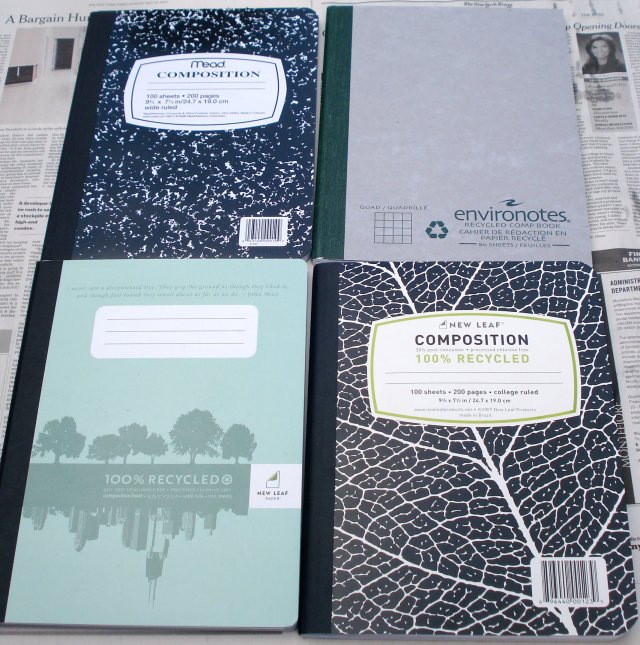
All except the Mead proclaim the use of partial or majority recycled materials. The Environotes stands out slightly with the muted colour scheme, square corners, and 80 (rather than 100) sheets. The New Leaf book easily had the brightest paper.
All have tables for class schedules on the front inside covers. The back inside covers have “useful information”, mainly weight and distance measurement conversions. The Mead is alone in having a grammar section.
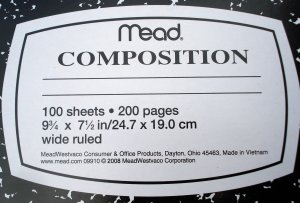 |
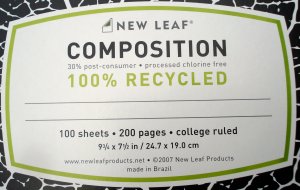 |
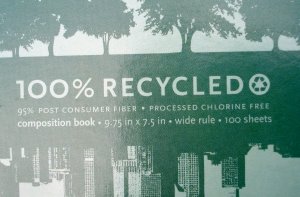 |
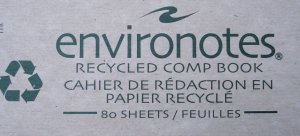 |
I have to note something about the price: each is $C4.29. The same bookstore sells a large Moleskine notebook for $C21.00. (Right now, one Canadian dollar is $US0.96 or €0.78.) They are not the same products at all – but the almost fivefold price difference surprised me.
The Mead composition book may in fact be magnitudes more successful than fancier fare. It doesn’t have an active PR department or online marketing team; it does seem to have wide distribution, being available in big box office supply stores, the stationery corners of department stores, and even the small university bookstore I visited.
Some online reviews suggest these books are not great with fountain pens or fibre tipped pens. I won’t dispute that. But trying a nice pencil, there is no problem at all. That is a typical pencil advantage – many paper types accept graphite quite easily.
I like the fancy brands, but the composition book still seems appealing for many purposes.
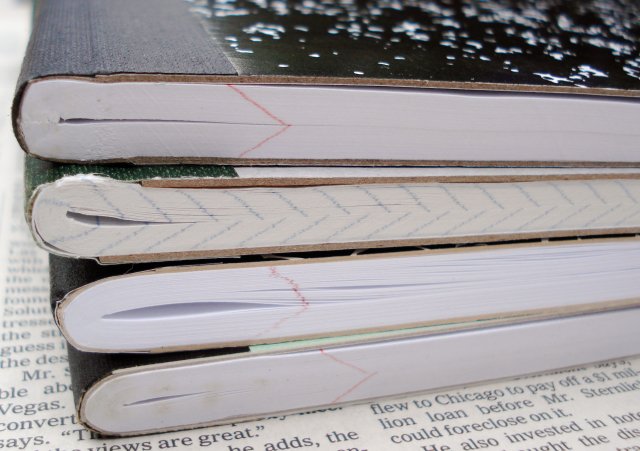
What do you think?

I love the traditional Mead Composition book, and I love it even more on the occasions I can find it in graph paper.
I find that Norcom makes a pretty decent one that takes fountain pen ink quite nicely. I usually find these at Walmart for under $1 US (cheaper at back to school time). My only gripe with those is that they are wide rule and I prefer college ruled. But still, best bang for the buck when it comes to paper.
These books look great, especially the one in the lower right with its vein structure of a leaf (which makes for a nice visual pun). – Maybe cheaper books and pads are more useful in the end since high-end notebooks with all the bells and whistles can hold back a first rough draft of an idea.
My sentiments entirely, Gunther. I sometimes find opening a posh notebook intimidating enough to scare a way a little idea.
Where can I get these though? The UK equivalent – we call them ‘exercise books’ – all seem to be a lot thinner.
Since I use 0.5mm mechanical pencils a lot, I find the sharp points easily tear some recycled paper.
What a beauty: the traditional Mead composition book! Anyone knows if they can be found in the UK?
Yes, the composition book is one of the few continuing stationery traditions left in the USA. I have always opted for the classic “marbled” Mead, to which I was introduced in elementary school. (A marbled Comp book and a box of Ticonderogas—that was happiness!) At back-to-school time, they can be purchased in bulk at 50 cents apiece or even less. There are some harder-to-find versions, like the blank paper or the graphed book, that more specialized stationery shops in Manhattan tend to carry. But I love the plain old classic. Roaring Springs also makes a good traditional comp book. I believe that Roaring Springs still makes their Comps in the USA, while Mead and Norcom produce in Vietnam, India and Brazil. Those made in Brazil are friendliest to fountain pens and have the smoothest paper. (Some Meads may also still be US-made but are not the ones you find most commonly.) And I agree 100% with Gunther’s comment!
I strangely don’t remember ever having or using a composition book of the exact style mentioned here. In East Asia, I’m not sure what difference there would be between a regular “notebook” and a “composition book”. Is the definition based on the binding style, or on the size? I’ve got a bunch of Apica, Kokuyo, and even a few Rhodia notebooks that strike me as being sort of similar. Actually, not too long ago I stumbled across a nice little A5 glue-bound non-perforated notebook from Double A (pretty big supplier of laser/copier paper) that has pretty decent 80gsm paper.
I’m trying to figure out a paper that is a good balance of smoothness and tooth for not only taking graphite, but also holding it without being abraded away over time by pages rubbing together. Clairefontaine paper I’ve got doesn’t really receive pencil very well, but perhaps since the graphite seems to get deposited in channels rather than on exposed peaks, the paper rubbing against itself doesn’t really affect the marks significantly. I’ve got cheap stuff that will make a Castell 9000 look almost as dark as a Black Polymer 999 because it’s so coarse, but after a few months or a year, most of the marks will be rubbed into a gray fog over the page. I guess the easy way to avoid it is to stick with rigid notebooks where the paper will not rub together much.
I would love to know what you call the traditional spatter pattern on the composition book. It’s extremely recognizable and evocative. One writer above calls it “marbled.”
I use the “Mead” style composition notebooks all the time for work (mainly “Office Depot” version). I am an engineer, and use them for meetings, conference calls, customer support things, etc. I have 11 of them stacked up on my desk right now for various purposes. Only college ruled.
I use my wood pencils with them when in the office, and a mechanical pencil when on work travel. Rarely use pens.
Great tool and nearly a perfect size to easily carry around. They also work great when I’m in a car with a sales rep traveling to see a customer, as I can take notes. Good size to take on a trip.
I was at a trade show recently, and a now deceased engineer/inventor used the Mead composition notebooks exclusively as lab notebooks. Many of them were opened to various yellowed pages in a historical display. All writing was in pencil.
I like to decorate the cover–usually sci-fi or geeky–and then cover the whole thing in clear contact paper. Personalizes and protects the notebook. I tend to use ballpoint in them because pencil is smeary and liquid/gel is bleedy.
@Robert: Yes, the Apica Notebook 6A10 is similar in size. Apica has higher-quality paper and binding, in my opinion. But it also costs about 13x’s the price. Currently using a moleskine (~20x’s the price) that someone gave me, but may go back to a 50-cent compy when the moleskine expires.
+1 for Gunther’s comment.
If you haven’t seen this blog entry, it’s the best compy post ever, IMO:
“26 Years, 85 Notebooks”
http://www.designobserver.com/observatory/entry.html?entry=6067
@David O.: When I use pencil, especially in these thin-paper notebooks, I get graphite transfer from one page to another. Maybe I’m pressing too hard. Sometimes when I really want to use pencil, I use a removable “blotter” page to protect from graphite transfer across pages. Your solution? (Including, maybe, “Just don’t worry about it”?)
You can find extensive discussions on various aspects of the composition book at The Fountain Pen Network.
Yeah, I get graphite transfer but I don’t worry about it (as you speculated). A paper layer is a good idea. I do that with my phone log so the desk surface doesn’t get too “graphity” (for lack of a better term).
I am a fan of composition books, especially the blank and quad ruled ones. They are cheap and sturdy.
I was hoping for a picture of the environotes grid lines. Sometimes comp books have horribly dark rulings, which I do not like. I can’t find the environotes locally and have been back-and-forth about ordering online. I haven’t been able to fnd an actual picture of the interior and I’m afraid I’ll order and find out the lines are too dark.
Geo, in the U.S. the spatter pattern has always (as far as I know) been called ‘marbled.’
The Meads are the only ones here I’ve seen — it’s a pleasure to see the others. Lab books are nice too. How I wish though that someone would revive the Royal “Vernon Line” composition book of my 1960s kidhood. It had varnished covers and watermarked paper. It’s wonderful to think of so much care going into the manufacture of a product used by schoolchildren.
Michael Leddy: I am surprised (if not upset) to see that – at least in Germany – the term “for school” is often a synonym for inferior quality. I don’t agree with that and would like to see the best in the hands of schoolchildren!
Gunther: I agree. When my children were younger and we shopped for school supplies, we always bought the best. My kids didn’t have the heart to tell me that their Mirados and Ticonderogas and Velvets went into a communal pencil supply with everyone else’s pencils.
@Gunther,
I agree. School supplies should be best quality. But the main consideration for most parents and schools is the cost. It has to be cheap! Because most of the teachers and the pupils treat writing utensils very “carelessly”.
So you can have it two ways: either you buy quality products, which can take some beating, or bulks of cheap ones, so it won’t matter if you loose one or two.
Here in Denmark most schools have chosen the second option: they buy pencils and ballpoints for free distribution among staff and students (BIC ballpoints and no name Chinese pencils in bulks). The idea is that you don’t have to bring your own – that’s fine, but the side effect is, that no one cares about their own or other peoples’ pencils (or pens for that matter).
I would have preferred that we had chosen the first option.
Regards
Henrik
I am always impressed, though, how in Germany most school children are very careful about their supplies. At one school that I visited, every child had a “Maeppchen” or folding pencil case that held pencils, sharpener, eraser, ruler, protractor, a Pelikano fountain pen, and extra ink cartridges, all in a very orderly manner, each tool in its designated elastic loop. None of that “I don’t have a pencil” excuse that you often hear from our kids here in the USA. On the whole, I found that German school children have rather high quality supplies.
When I was a child in the 1970’s here in the USA we had to make sure we had our own pencils. I remember buying them in the little school supply store. They were stamped with the grade school name and mascot name (Indians). I am 48 years old now, which I guess was before the age of “communal” pens and pencils, etc. I ended up buy some of the blue/gray “Ticonderoga with Microban” pencils recently, as their color reminded me of those old grade school pencils, which were a light blue.
As an aside, I don’t know why I should like pencils so much as I have a permanent mark in my right palm from pushing my books into my locker when I was 13 or 14 years old. A sharpened pencil was pointing out and stuck into the palm a bit. Still have the internal graphite mark after all of these years.
Another vote for the Norcom composition books manufactured in Brazil. I, too, prefer college rule and can occasionally find the Norcoms in that configuration, most recently at Office Depot (just one store–no other Office Depot I went to had them). Wal-Mart usually stocks tons of the Norcoms at back-to-school time (and their shipments may be showing up now), and I’ve seen college ruled there at that time.
One thing I love about composition books is that they seem to be a uniquely American style of notebook. I’ve often wondered about their history and how the size, style, and configuration of these wonderful notebooks came to be.
I agree with Steve and have also wondered about the history of these notebooks. I used them as a school kid in the 1960’s, but I think they must be older than that. Not much about them in terms of their history can be found on the web.
I’ve seen these kind of notebooks a lot, but I never used them while I was in school. I usually had the spiral-bound Mead notebooks.
Also, I always see them in wide-rule. I’ve never found a college-rule version which was disappointing since I remember wanting one of these, but never getting it because it was _always_ in wide-rule.
Now I’m curious too how far these go back. I don’t recall ever using one, but they certainly are iconic, and it strikes me as odd that their history largely goes unmentioned.
@Pisces6
As far as I know, the New Leaf comp books (the one with the leaf pattern “marbling” in the picture at the top of the thread) come only in college rule. When I first started seeing the New Leaf notebooks, they were all manufactured in Brazil and their paper was on a par with the Norcom Brazilians, but lately I’ve noticed that they are being manufactured elsewhere and the paper from these other countries is not as nice. Also, if you have access to a college book store, they will often have college ruled comp books (naturally).
A history of the American composition book sounds fascinating. I wonder if they began around the 1940’s or so. The comp book is one of those simple, ubiquitous objects that few people stop to consider in terms of history or influence. Such a study though might yield very interesting facts about American education and writing. Maybe a note to Mead or to Roaring Springs is a good place to start?
On ask.com, someone noted (no pun intended) that the spiral notebook was invented in 1924 (lots of inventions in the roaring twenties), but I couldn’t find anything about the humble composition notebook.
@Steve
Oops, I forgot to mention that it’s the Mead Composition notebooks I’ve never seen in college rule. I’m not familiar enough with the others to know what sort of paper they typically have inside.
@Pisces6
You should try out a Norcom composition book (just be sure it’s made in Brazil). The paper is the best of all the composition books I’ve seen. You may have to look for a college ruled version, but I know they exist. And since you can get them for cheap (less than a dollar sometimes), you won’t be risking much.
They certainly exist, Pisces6, and you will have most luck finding them at a college boostore. If you happen to be near New York, Stevedan’s carries the full range, including all-blank and graph versions.
I wrote to Roaring Springs and inquired about a history of the comp book. I’ll share the response if I get one!
I’ll see if I can find a college store near where I live.
@adair
I live on the West Coast, so I won’t be able to visit the Stevedan store. Sounds like a fun store to visit though!
The local WalMart carries Mead 5 Star comp books that are college rule. They have a plastic cover, similar to the spiral bound notebooks. They are more expensive, though. About $5 for the 5 Star comps compared to $0.25 for the Norcoms. Unfortunately, I can never find Norcoms in college rule, only wide.
A heads up on college ruled composition books. I was just at an Office Depot in the Atlanta area and they had a nice supply of Norcom composition books with Brazilian paper, $1.99 apiece. I’m sure availability varies by region and from store to store, but it might be worth checking out if your in the neighborhood of an Office Depot sometime.
Composition books are great for recording project notes and I keep separate books with separate projects. I had several cut down at the copy shop so they’d fit in plastic shoe boxes with their projects; I think it was 50 cents each for the cutting.
I, too, am a fan of the graph paper versions!
Pisces: as Steve says, Office Depot carries Norcom college-ruled. I saw some today for $1.29—not bad.
I also went to Walmart, but alas, only empty boxes—every single comp book had been sold at 25 cents each!
There is a store in Berlin that on occasion carries Mead Composition Books for the hefty price tag of 4.50 Euros each. I don’t know about shipping, but I think since it is a small store, that you could negotiate shipping via Deutsche Post / DHL. The store is called R.S.V.P., the contact email address can be found here. Let me know if you need a hand with communication. (I am sure they speak English.)
Yes, I saw the 25-cent Norcom composition books at Wal-Mart. They were cleaned out in about a week. Some were made in Brazil and some in Vietnam. The Brazilian paper is superior to the Vietnamese. I only saw wide rule versions, and the covers were noticeably lighter weight — not the heavy board covers one associates with comp books. That’s probably how they got the price so ridiculously low (which is what I don’t like about Wal-Mart, insisting on the lowest price possible at the expense of quality).
I will be on the lookout for whether this lighter cover winds up on the college rule versions such as those at Office Depot. Right now all the ones I’ve seen are still the heavier covers. If the lighter covers become the rule for Norcoms, it will be the end of the best composition book currently on the market IMHO.
Thanks for the heads-up about the soft covers, Steve. I won’t bother to find another Walmart, in that case, as I dislike those floppy covers. I agree, the traditional hard-covers are best. Sometimes, Rite Aid has a good sale on the hard-cover Mead Comp books (some from Brazil, others from Vietnam and even the USA). I’ll wait for that. Meads are pretty classic and sturdy.
(I’m from UK) US Black marbled composition books are to me the absolute tops if you can get them really well made with stiff backs and quality no bleed thro paper – the fact that they’re so robust and low priced makes them unusually suited for almost any writing task BUT YOU CAN’T BUY THEM IN UK ! absolute madness,I’ve no idea why not, I’ve been searching for 2 years,no one’s interested in supplying them … Eventually I got a retailer in New York to agree to ship 40 to me last year (2009).Maybe some entrepreneurial UK business will one day pick up the baton? but probably not – I don’t think we’ve got any of those left!!
Disgruntled Comp.Book Fan
I’ve found a new favorite brand—the house brand at CVS drugstores, called CALIBER. They come with marbled covers or in blue or red. Some are made in the USA, others in Vietnam. I think the USA ones are older stock, but the paper is better. CALIBERS have good stiff covers and nice, somewhat old-fashioned cover-labels for your name. Try one!
Growing up, I lived in Saudi Arabia for a few years where my Dad worked. The American Embassy school I went to gave out the marbled specked black composition books as well as ones that had a light brown sort of cover. The school also gave students ‘Venus’ pencils, little pink erasers and everything else that you could need for school. Everything was shipped in for the school from the US! I remember loving the smell of Crayola crayons!!
I sought out the Caliber composition books at CVS yesterday, and I must say that the covers are about the best I’ve seen as far as sturdiness and appearance. Very nice. I only saw wide ruled versions, but I would be interested in these if they came in college ruled. Thanks for the tip Adair!
I have a photocopy of the cover and pages of a Composition Book that was used in 1893 to practice writing. It belonged to a 10 year old girl who wrote the names of her ancestors and thier children to practice her writing skills.
That means they have been around at least as early as 1893.
I lived in Bakersfield, California for a couple years and had the chance of going to an estate sale. Pretty fascinating to say the least. At the estate sale I noticed some old Eastman brand Classmate composition (note)books, no. 1020 and acquired 20 of them for about a dollar. They are smaller, 10×7-7/8 with 20 sheets to a book which leads me to believe they were probably for grade school in the 1930’s or 40’s. They don’t have the hard cardboard covers like Mead but they do have the conversion and multiplication table in the back and serves a purpose. I tried looking for the history on the notebooks but couldn’t find anything close. It would be interesting to know the history but I guess because of the many companies that produced writing paper during the era, it would close to impossible to really collect all the information. Oh well, just thought I’d share that bit of info.
Great post, these were de facto travel notebooks for my hobo days and I’m ever fond of them. Big, wide pages that worked with any old pen or pencil and inconspicuous enough to write in without arousing paranoia in traveling companion.
If you like composition books and solving problems by writing there’s a new book Thinking Anew: Harnessing the Power of Belief. http://www.helpthinkinganew.com. The book’s cover is a marbled composition book with a number two pencil on it. The author, a psychotherapist, has been using composition books as a learning tool to help people in crisis find the passion to make change stick.
Hello,
Our institution acting as potential buyer of your products and services,request a quote for the following product (s)-
(1) Mead Composition Book 7 1/2″ x 9 3/4″ 70 double-inside white sheets with blue ruling for 140 pages of notes—-(QTY 20,000)
Please revert back to me with all relevant information, options, and suitable alternatives.
Note: In addition to the above,Our institution standard Payment terms:Net 30 days from the date of supply with the supplier’s Invoice.
Regards,
Jacob Kavunkal
Procurement Director
University of Maryland
223 Arch Street, Office
Baltimore, MD 21231
Phone:(410) 670-0894
Email: quotes@umd-edu.com
Jacob, this website does not sell any stationery products.